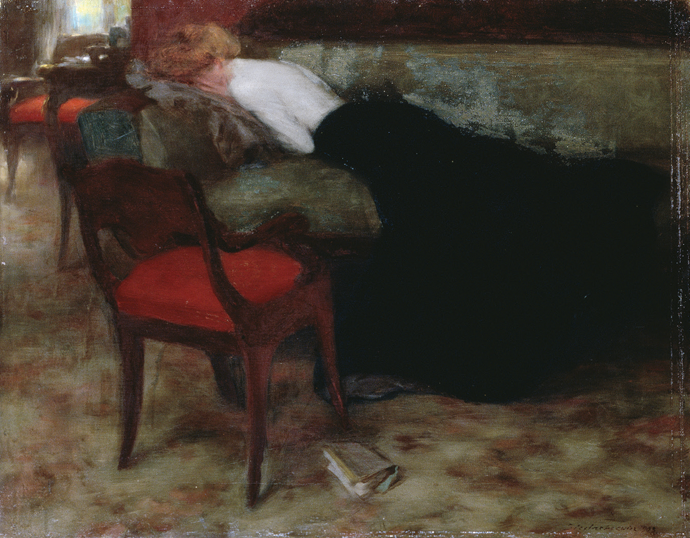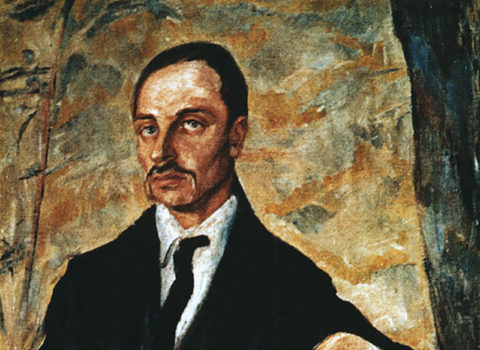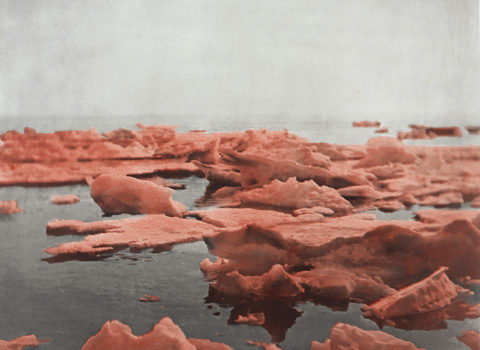Discussed in this essay:
The Crying Book, by Heather Christle. Catapult. 208 pages. $16.95.
Machine, by Susan Steinberg. Graywolf. 144 pages. $15.
The Undying, by Anne Boyer. Farrar, Straus and Giroux. 320 pages. $26.

Despair, by Stanisław Bohusz Siestrzeńcewicz © Mazovian Museum, Płock, Poland/ Bridgeman Images
On the morning of my friend’s funeral, my period arrived two weeks early and with a sudden force that ruined the black clothing I’d brought and the rickety chair I was sitting on. Its cushioned seat, my other friend and I discovered, was detachable, so we trashed it, leaving the empty wooden frame at her kitchen table for days after. It looked like a metaphor, except it couldn’t carry anything. Telling you this nonstory feels excessive, embarrassing, in poor taste, even though death and grieving often feel that way, too. If you’ve read this far, I’d guess your reaction is somewhere between awkward compassion and annoyance at the undisciplined spill of emotion and its bodily display, the apparent eagerness, rather than building an argument, to make a mess and declare it worthy of attention. I felt a similar irritation as I began the poet Heather Christle’s memoir-cum-study-in-fragments The Crying Book (Catapult, $16.95), which interleaves the results of several years of research into the art and science and history of tears with the soggier aspects of her everyday life—losing a friend to suicide, having a child, weeping copiously over artworks or conversations or, just as often, when overcome with unexplained despair.
My reflexive irritation recalls that of the Artforum critic who once infamously branded Chris Kraus’s I Love Dick “not so much written as secreted”—a standard dismissal of anything that threatens to take seriously bodies and emotions and other things considered womanish. Christle is way ahead of me, by turns accusing and poking fun both at herself (“most days I cry more than I write about crying”) and at those who pathologize or condemn the outward signs of suffering. She jokes of the tear-filled autobiography of the medieval mystic Margery Kempe that “We had a wet beginning!” and insists on the value of things that could provoke distaste: “I love to find small stains in used books, wondering which ones originate in the lacrimal glands of weepy readers.” There’s an interest, throughout, in texts and expressions that reach beyond representation, pointing out of their frame toward the real. Noting that her “tear-swollen face would discredit” her with experts, Christle nonetheless deftly exposes flaws in expert thinking. It should perhaps be no surprise that crying doesn’t bring out the best in social scientists, though there are special horrors gathered here, such as the psychology grad student who, seeking to extend the range of his study to non-white people, wrote to W.E.B. Du Bois to inquire whether “the negro sheds tears” at all. The short book feels strangely capacious. It considers the men whose grief and rage, denied one physical outlet, find another; Christle’s own strong and immediate impulse to police her husband’s tears of frustration or exhaustion, instinctively reinforcing the miserable gender norms she attacks elsewhere; and the way the tears of white women like herself (or merely the possibility of them) have been used with fatal consequences against black men. Not every entry earns its keep. Christle’s view of motherhood can seem cloying; a statement such as “Milk and tears are the only bodily fluids humans can generally imagine drinking without overwhelming disgust” is not evocative enough to make up for the fact that it’s demonstrably untrue.
Yet the book’s effects are sly and cumulative, relying not so much on any one observation as on associations, echoes, contrasts—a method that reflects Christle’s view of art and life, the interdependence, the complex contagion and repetition of feeling and action and reaction that marks them. The Crying Book doesn’t command or seduce its readers, instead offering a developing sense of comradeship—if you choose to stay, you’re rewarded. It’s about grief and friendship, but only delicately so. Christle wants to preserve the particularity of experiences while illuminating what they have in common. Again and again she emphasizes that separation: “It is dangerous,” she insists, “to always think one thing is another, every event a metaphor for another.” This is also to say that writing itself is dangerous, as well as essential. As Christle writes: “Maybe we do not cry about, but rather near or around.” Like the unconscious, she favors correspondences over strong causal links. “Perpendicular lines,” she suggests, “are Chekhovian; the introduced gun goes off. Parallel lines are Hitchcockian; the present bomb is enough.”
Susan Steinberg’s slim debut novel Machine (Graywolf, $15) likewise considers how collective fantasies and sufferings are gendered. The book thins plot and character into stereotype—rich girls summering at the shore; spoiled, drunk, pushy young men; a poorer local girl drowned, and shamed before and after; a weakling mother and an unfaithful, bullying father—and shows, in taut, incantatory sentences, often laid out like poems, that the story nonetheless stays in motion; the reader still responds as bidden. The narrator slips between “I” and “we,” her identifications and allegiances smudging between family, other teenage girls she runs with, and girls as a category, sharing some qualities and not others. (Class, that other form of social and narrative fate, is heard grinding its gears.) Early on come teasing allusions to what will be left out:
I’ll say the color of the walls; the color of my hair; the color of her hair; our heights, our weights; say there’s no such thing as fiction; say there’s only substitution; there’s only this standing in for that; and her standing in for another her; and her for another and so on.
The reader is moved precisely by the young women’s dawning awareness of how little their particular gifts and desires may matter, how unoriginal and undignified are their pains and disappointments. There’s “no point in building her character here,” the narrator says of the doomed girl, “no point in building the perfect girl you always want; / so here’s any girl holding her shoes.”
The text is repetitive but disciplined, riddled with voids and awash with semicolons, which often begin and end a chapter; Steinberg can go pages without a period. That semicolon—once dismissed by journalist James Kilpatrick as “pusillanimous, sissified”—emerges again as implicitly gendered: ambiguous, untrustworthy, or maybe just a little indecisive, the mark that’s always letting something seep through into something else, porous as girls are supposed to be. Shifts of grammatical mood and tense have palpable effects: much of the action takes place somewhere between the conditional and the inevitable, the needn’t-happen and the already-too-late. Suspense is sustained even within and between phrases. Take a chapter called “Liars,” in which the narrator considers the fate of the girl who may or may not have been grabbed, drugged, pushed:
and were there pills in the body;
were there hands on the body; . . .
were we to dust the dock for prints;
were we to dust her skin for traces of hair, for traces of other skin;
were we to trust my older brother;
were we to trust his asshole friends; . . .
were we not this tight-knit group;
were we not this pleased with our fancy selves;
and our circular drives and our heavy gates;
and our terraces and our lawns; . . .
The meaning is clear yet stays a touch off-balance, dancing between a “were we not” that could connote “if we were not” or even “given that we were not” and something, in the spirit of “do we not bleed,” closer to “we were” (while “were we” lingers between “what if we did?,” “we shouldn’t,” and “we should have but didn’t”).
The novel examines youthful experiments with the boundary between self and other, the hope and fear of losing control. Another girl dares the narrator to steal a purse, not knowing its owner is someone on whom the narrator would like vengeance. Via the established principle of substitution, this theft forms a violent, sexualized network, except that things are also what they are, not only what they represent:
she never gives a shit whose thing it is; she always just wants the thing itself; she just wants the things inside the thing; but I want the owner of the thing; I want to own the owner in some brutal way; I want to own this woman in that way; so which one of us now is in charge; is it the one who dares the other; or is it the one who dares to do the fucking thing.
Whereas the narrator’s father tells her that her first word was “star”—“He saw it as a sign of some great thing. That I was destined, he said, to be that”—her browbeaten mother balks: “My father, she said, was pulling my hair. And one can see, she said, how what I said, which was stop, pointing not to the sky, but to my head, might have sounded like star.” The narrator, studying science, is understood to be a different breed from the girl who dies, but still there’s confusion around what she can do as against what might be done to her, and how these things, her potential and her vulnerability, are connected, both being so often, for girls, a question of how they’re looked at.

Hospital 2, a painting by Gina Heyer © The artist. Courtesy private collection
As the poet Anne Boyer writes in The Undying (Farrar, Straus and Giroux, $26)—a memoir of breast cancer in an age when silence around the illness has been replaced by endless, ideologically charged noise—“Visibility doesn’t reliably change the relations of power to who or what is visible except insofar as visible prey are easier to hunt.” Boyer’s book, ambitious in scope, is honed to a precision that feels hard-won. The politics of illness—how the profit motive determines life and damage and death; how victim blaming is enshrined; how social norms can disable and kill—have rarely been limned with such clarity and grace. One of Boyer’s many gifts is for framing and juxtaposition, vividly exposing connections between structural injustice and personal suffering. She depicts the coercive emphasis on positive thinking (seeing the headline “Attitude Is Everything for Breast Cancer Survivor,” she imagines using the same formula for sufferers of Ebola, diabetes, lead poisoning, gunshots) and on each triumph, each tragedy, as an individual yet suspiciously repetitive phenomenon, the exact way it looks and feels when people are getting systematically screwed.
Boyer observes that the chemotherapy drugs that caused her permanent cognitive and physical damage were chosen as more profitable over a safer and equally effective alternative. Knowing the poisons that flowed through her have a long and destructive half-life, she also wonders how to justify the environmental cost of her survival. Then there’s the recurring sense of being, in sickness, forcibly feminized. The United States is, Boyer wryly notes, a place where it’s considered more important to have appealing tits than a working brain. “Despite the lie of progress,” she writes, people nowadays are often forced out of surgery without rest time or adequate pain medication:
while they don’t get a hospital bed to recover in or rehabilitation for the cognitive damage incurred during their treatment, what they do get in the United States is federally mandated access to breast reconstruction—any type of implant they want.
Yet more disturbing is her account of the way cultural expectations distort the course of treatment:
Maybe medical historians will view chemotherapy with the same perplexed curiosity that ours do formerly common medical practices such as bloodletting—that not only did we severely poison people in attempts to make them well, but that even in those instances when chemotherapy doesn’t and won’t work and results in death, damage, and disability, there remains a popular desire for breast cancer patients to undergo it. When it isn’t motivated by profit, this overtreatment seems to result from superstition. . . . It is as if the world itself is captivated by the unholy rites of the infusion room and the sentimental dramas of lost hair, wasting limbs, weakened women.
Boyer looks at the writer Kathy Acker, whose death is still routinely represented as the result of some kooky, irresponsible rejection of conventional treatment. According to Boyer, the form of cancer Acker had kills within a similar two-year period whether or not the patient undergoes chemo, which may even speed the decline, in addition to ravaging the body and mind. “Instead of opting for the painful death that she was offered by the available medicine,” Boyer observes, Acker chose to use the time she had left for living. But such choices often come at a cost, because those around the patient find them so hard to accept. “Refusal can be isolating: the social enforcement of medical compliance around a gendered disease like breast cancer, brutal.”
Likewise, though in theory people are now freer to live as they choose, some are in effect punished for doing so—what social shame once enforced is now taken care of by brute economics. In The Undying, Boyer is diagnosed at forty-one, a single mother with a thriving career: since sick days are limited and “if you aren’t someone’s child, parent, or spouse, the law allows no one else guaranteed leave from work to take care of you,” she continues to work in a potentially life-threatening state. “Black women have both a lower rate of being diagnosed with breast cancer and a higher rate of mortality from it,” she writes.
Unmarried women have a greater risk of dying from their breast cancer, too, and of not receiving adequate care for it. Breast cancer patients who live in poor neighborhoods have a lower survival rate at every stage of diagnosis. Unmarried breast cancer patients who live in poor neighborhoods have the lowest survival rate of all.
For Boyer, pain is political. She goes directly for the contradiction at the heart of Steinberg’s experiment: women suffering from the same condition (womanhood) and yet separated by the unequal conditions of their suffering. She quotes Susan Sontag’s claim that “Women don’t die for each other. There is no ‘sororal’ death.” Boyer disagrees: “It is death in an alienated parallel. A sororal death would be women dying of being women.” In a chapter whose epigraph is from Margery Kempe, she recalls an idea she once had that might appeal to Christle, too, “to install in major cities an almost-religious monument where anyone who needed it could get together to cry in good company and with the proper equipment” (including “stately public marble troughs in which to collectivize their tears”). She especially enjoyed figuring out how to handle “people who have hated those they call crybabies,” envisioning a
space for the physical expression of both singular and common sorrow, a place that both comfortably exposed suffering as what is shared and that guaranteed some protection against anti-sadness reactionaries.
The project never materialized, though at one point chemo’s side effects temporarily turned Boyer’s body into “a mobile, embarrassed public monument of tears. I didn’t need to build the temple for weeping, then, having been one. I’ve just always hated it when anyone suffers alone.”


































































































